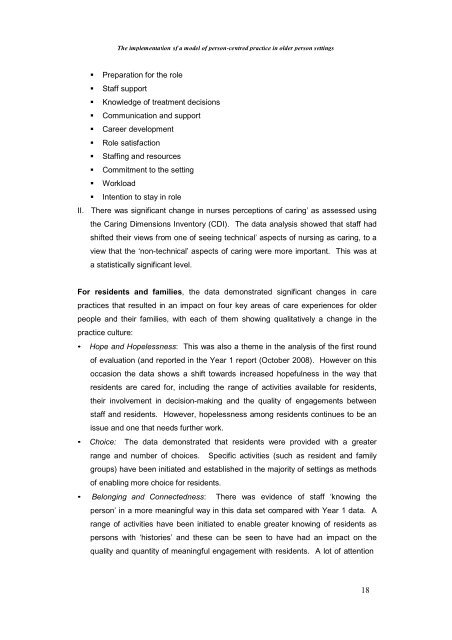The Implementation of a Model of Person-Centred Practice In Older ...
The Implementation of a Model of Person-Centred Practice In Older ...
The Implementation of a Model of Person-Centred Practice In Older ...
You also want an ePaper? Increase the reach of your titles
YUMPU automatically turns print PDFs into web optimized ePapers that Google loves.
<strong>The</strong> implementation <strong>of</strong> a model <strong>of</strong> person-centred practice in older person settings<br />
Preparation for the role<br />
Staff support<br />
Knowledge <strong>of</strong> treatment decisions<br />
Communication and support<br />
Career development<br />
Role satisfaction<br />
Staffing and resources<br />
Commitment to the setting<br />
Workload<br />
<strong>In</strong>tention to stay in role<br />
II. <strong>The</strong>re was significant change in nurses perceptions <strong>of</strong> caring’ as assessed using<br />
the Caring Dimensions <strong>In</strong>ventory (CDI). <strong>The</strong> data analysis showed that staff had<br />
shifted their views from one <strong>of</strong> seeing technical’ aspects <strong>of</strong> nursing as caring, to a<br />
view that the ‘non-technical’ aspects <strong>of</strong> caring were more important. This was at<br />
a statistically significant level.<br />
For residents and families, the data demonstrated significant changes in care<br />
practices that resulted in an impact on four key areas <strong>of</strong> care experiences for older<br />
people and their families, with each <strong>of</strong> them showing qualitatively a change in the<br />
practice culture:<br />
• Hope and Hopelessness: This was also a theme in the analysis <strong>of</strong> the first round<br />
<strong>of</strong> evaluation (and reported in the Year 1 report (October 2008). However on this<br />
occasion the data shows a shift towards increased hopefulness in the way that<br />
residents are cared for, including the range <strong>of</strong> activities available for residents,<br />
their involvement in decision-making and the quality <strong>of</strong> engagements between<br />
staff and residents. However, hopelessness among residents continues to be an<br />
issue and one that needs further work.<br />
• Choice: <strong>The</strong> data demonstrated that residents were provided with a greater<br />
range and number <strong>of</strong> choices. Specific activities (such as resident and family<br />
groups) have been initiated and established in the majority <strong>of</strong> settings as methods<br />
<strong>of</strong> enabling more choice for residents.<br />
• Belonging and Connectedness: <strong>The</strong>re was evidence <strong>of</strong> staff ‘knowing the<br />
person’ in a more meaningful way in this data set compared with Year 1 data. A<br />
range <strong>of</strong> activities have been initiated to enable greater knowing <strong>of</strong> residents as<br />
persons with ‘histories’ and these can be seen to have had an impact on the<br />
quality and quantity <strong>of</strong> meaningful engagement with residents. A lot <strong>of</strong> attention<br />
18
















